Hot Water Re-circulation
Not all home automation surrounds fancy electronic gadgets interfacing with home systems. In this article we are going to cover a fairly low tech solution to a very common problem encountered in many households: hot water. Or rather then lack of hot water when you need it.
The Problem
If your home was built like mine, then very little consideration was given the efficiency of the hot water distribution system. Many if not most homes in North America simply have a single hot water main (trunk) line that starts at the top of the hot water heater and then extends to the furthest point where hot water is needed in the house and branch lines may be tapped in to carry hot water to other locations. If you are lucky you may have a balanced system using a manifold where each endpoint is serviced from a dedicated line from the manifold. (If I ever build a house, I will install that type of system.)
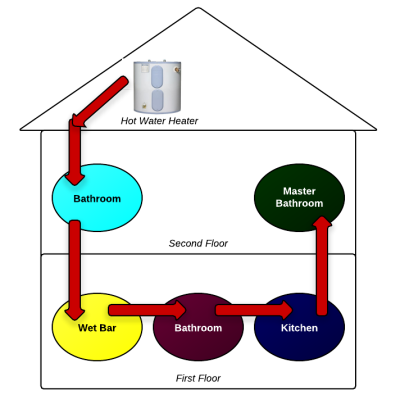 The illustration to the right is a rough approximation of the hot water distribution system in my home.
The illustration to the right is a rough approximation of the hot water distribution system in my home.
As you can obviously see in the illustration, this system has some pretty significant drawbacks. Namely, the master bedroom and kitchen, arguably where you would use hot water the most, are the two farthest locations from the source of the hot water: the hot water heater. This means that when the lines have not been recently used it takes a significant amount of time for hot water to reach these destination. I have timed it taking up to four minutes for hot water to reach these destinations in my home. So, when you want to wash dishes or take a shower, you have to turn on the tap and waste several gallons of water just waiting for it to warm up. That is unless you enjoy cold showers. :-)
Your system may be constructed differently but if you experience a significant delay between turning on the tap and getting hot water, then read on .. this article is for you!
The Solution
To address this type of problem, one effective solution is a hot water recirculation system. A hot water recirculation system detects when the water at the destination tap location is cold and then pumps hot water through the pipes to make sure hot water is readily available on demand. Each hot water recirculation system may have slightly variant features and behaviors but fundamentally this is how they work.
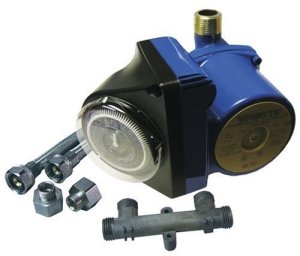 Watts 800500 Premier Hot Water Recirculation System
Watts 800500 Premier Hot Water Recirculation System
The Equipment
For my home, I selected and installed the Watts 800500 Premier Hot Water Recirculation system. This model is readily available at
Also this unit has received pretty good reviews: Amazon Reviews, Lowes Reviews, Home Depot Reviews. I encourage you to read the reviews to determine whether this is the right unit for your particular needs. There are several other brands on the market with similar features, so look around for what may fit your needs best.
How It Works
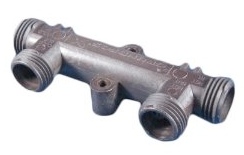 So how does this work? How can it pump hot water through a closed pipe system? It turns out all the magic is handled in the water sensor valve, the glorified "tee" or cross connect bar that is included in the kit. This device contains both a temperature sensor and valve. As the hot water sits in the pipe, it gradually looses its heat and becomes warm and then cold. This sensor is designed to detect when the hot water is no longer hot and then opens its internal valve allowing water to move from the hot side into the cold side. The water pump installed on the hot water heater provides the positive pressure to ensure that the hot water side it at a higher pressure (PSI) than the cold side, thus forcing the water to move from the hot side the cold side. See the illustration below for more details.
So how does this work? How can it pump hot water through a closed pipe system? It turns out all the magic is handled in the water sensor valve, the glorified "tee" or cross connect bar that is included in the kit. This device contains both a temperature sensor and valve. As the hot water sits in the pipe, it gradually looses its heat and becomes warm and then cold. This sensor is designed to detect when the hot water is no longer hot and then opens its internal valve allowing water to move from the hot side into the cold side. The water pump installed on the hot water heater provides the positive pressure to ensure that the hot water side it at a higher pressure (PSI) than the cold side, thus forcing the water to move from the hot side the cold side. See the illustration below for more details.
 Conceptually, here is what the entire system looks like when the sensor valve is in the closed state. Hot water is isolated to the hot side and cold water is isolated on the cold side.
Conceptually, here is what the entire system looks like when the sensor valve is in the closed state. Hot water is isolated to the hot side and cold water is isolated on the cold side.
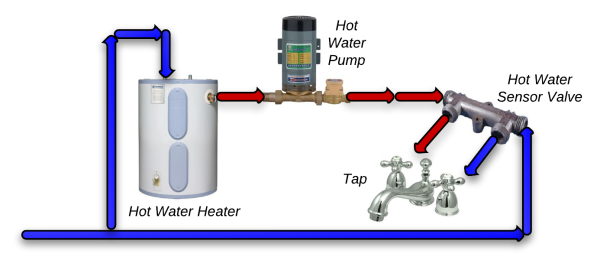
This next illustration depicts the system when the sensor valve is open and no-so-hot water is being pumped through the cold lines until it reaches the optimum hot temperature and the valve shuts off.

The illustration below depicts the house retrofitted with this hot water recirculation system. The hot water sensor valve should be installed at the farthest location from the hot water heater. This may not mean physically the longest distance away, but the location that takes the longest to receive hot water. Depending on how your specific hot water distribution system was designed, you may need multiple hot water sensor valves installed in multiple locations. This is especially true if you have branch lines that carry the hot water to distant locations.
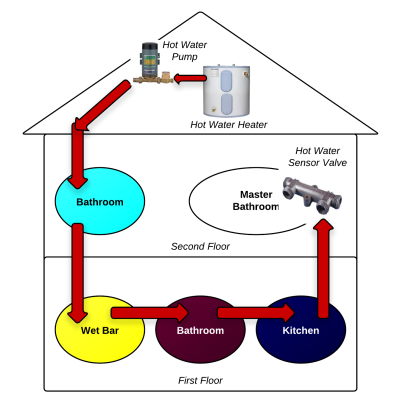
The Installation
Installing this system is pretty simple and straightforward if you are handy with tools and willing to get your hands dirty. If you are not comfortable with basic plumbing or working with your hot water heater, then this should be a simple 1-2 hour job for any plumber. Note: take precautions when working with the hot water heater to shut it off, release pressure, and drain it while working with it. Hot water heaters are pressurized and may be holding scalding hot water. Use caution!
Here is a link to the full instruction and installation manual for the Watts 800500.
Here is a professional video walking you through the installation steps required.
Below are installation photos.
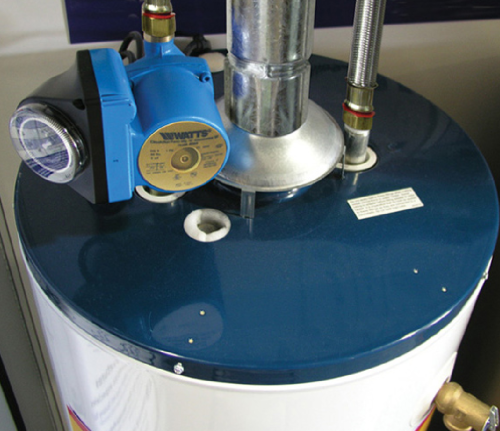 Not my installation, but a great photo of the pump installed on top of the hot water heater
Not my installation, but a great photo of the pump installed on top of the hot water heater
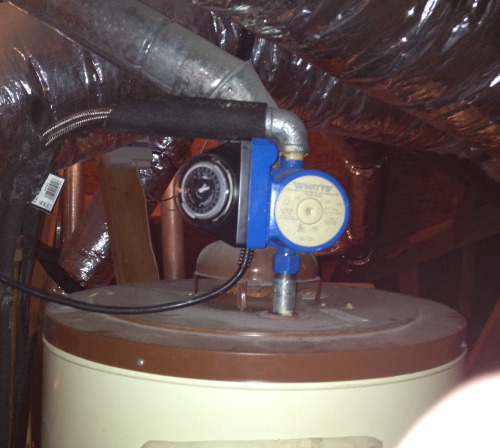 Hot water pump installed on hot water heater in attic
Hot water pump installed on hot water heater in attic
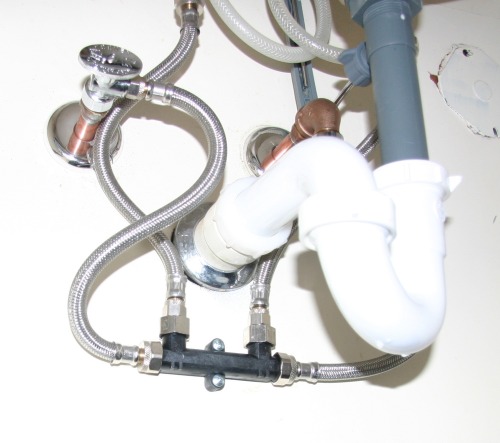 Hot water sensor valve installed under bathroom vanity
Hot water sensor valve installed under bathroom vanity
Timing / Energy Usage
The Watts pump includes a timer ou can use to schedule what times of the day you want the pump to be active. This is helpful to conserve energy. For example, during the day when you are at work and the kids are at school, there is probably no need to be recirculating hot water. Recirculating hot water when no one is using it does consume electrical energy to operate the pump and maintaining hot water in the lines consumes the energy needed to heat additional water, this may be using natural gas or electrical energy. So you'll have to strike a balance between energy conservation, convenience, and water waste. In my home, I have it scheduled to run between 6 am to 9 am and 7pm to 9 pm, the peak hours that we use hot water. So mine system runs about 5 hours a day opposed to 24 hours a day.
Final Thoughts
We have been extremely happy with the decision to install this system. The water being wasted down the drain just waiting for it to get hot was really weighing on my mind -- we live in a drought area. Not to mention the frustration of having to wait several minutes for hot water to show up. So far this has been a maintenance free solution .. well almost .. you do have to synchronize the time on the timer to account for daylight savings time changes twice a year. A pretty insignificant task.












 Sunday, March 4, 2012 at 5:00PM
Sunday, March 4, 2012 at 5:00PM
